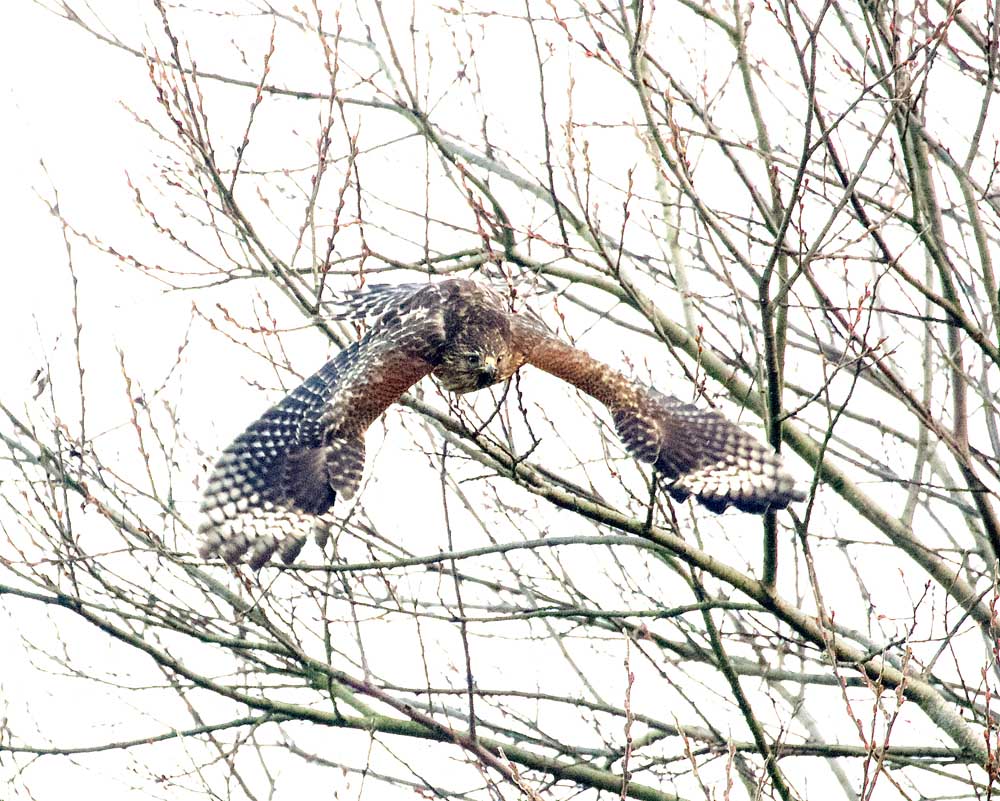Birding: A forest hawk, perch hunter and lover of tall trees and water
Published 1:27 pm Monday, January 24, 2022

- The barred black and white tail and the red shoulder patches are definitive ID markers.
There is a relatively new bird being seen in these parts. It is a perch hunter that feeds mainly on small mammals, amphibians, invertebrates, and reptiles. It will, however, take small birds, fish, and insects. In addition, it will eat carrion. The red-shouldered hawk is one of the new birds on the block. It is mainly a bird of eastern North America but is also found in the coastal areas of California, Oregon and now more often on the Washington coast.
Trending
Wheeler (2018) indicates that the subspecies, known as the California subspecies we are beginning to see here is “common in its core Calif. Range, but uncommon and local northward.” It is touted as being the most highly adaptable of the various red-shouldered subspecies so it is not surprising to see that it seems to be extending its range into the coastal areas of the state of Washington.
We, who live on the peninsula are the beneficiaries of the red-shouldered hawk’s movement. There is habitat for it so it may become a permanent resident in our area. This beautiful perching hawk will delight every time it is seen. It is currently designated rare on the checklists of birds for Pacific County and the Willapa National Wildlife Refuge on our peninsula. It is even being reported as a rare bird sighting by e-Bird of late. I have seen it at Cape Disappointment, in the trees at the edges of the llwaco harbor and at Tarlatt. Other birders have reported it as being in these same areas. There is evidence of nesting in Oregon but to my knowledge not in Pacific County. Where it does nest, it is a permanent resident.
The red-shouldered hawk is a buteo, as is the more familiar red-tailed hawk. Buteos are defined by almost every scientific source as those hawks that have robust bodies, relatively short, fan-shaped tails, and broad wings. These two hawks are similar, so it is wise to know their differences. The red-shouldered is smaller than the red-tailed hawk and sports a reddish — orange, rusty belly as well as a black and white barred tail. It has red shoulder-patches which are a definitive ID marker. The red-tailed wears a dark belly band and has a reddish tail. Red-tails prefer open areas such as fields and pastures whereas the red-shouldered hawk prefers forests, woodlands, and water.
Trending
Watching a red-shouldered hawk on the hunt is a sight to behold. It sits high perched and ready for the swoop to snatch and grab an amphibian, snake, vole, toad or even a small bird. It seemed to be a patient bird when I observed it. However, as with the red-tailed that I mentioned in a previous article, its patience soon wore thin and off it sailed wheeling across the sky from the Ilwaco harbor toward the tall trees of Cape Disappointment.
The red-shouldered hawk is a forest hawk, perch hunter and lover of tall trees and water. While it is rare here, the number of recent sightings suggest that it is expanding its range into our coastal areas. I think the peninsula is the perfect habitat for a red-shouldered hawk! I hope the red-shouldered hawk thinks so too. Happy birding!









